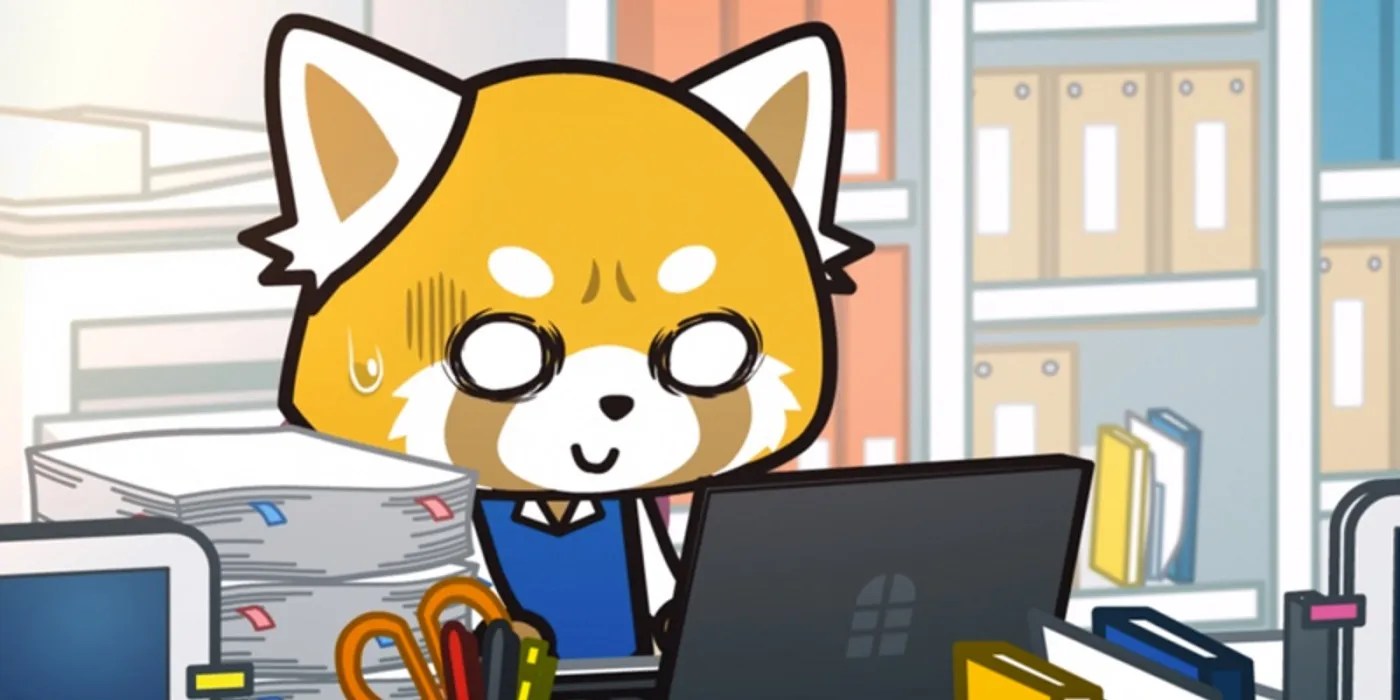At first blush,Aggretsukois just another hyper-cutesy brand from Sanrio, the folks behind Hello Kitty. Retsuko the red panda is stuck in a terrible office job during the day, and works out her angst by singing death metal at karaoke. That premise was the franchise’s initial concept, presented as animated shorts for a couple of years starting in 2016. In the time since, however, the series has found great popularity as a 10-minute episode serialized show by studio Fanworks. But it became quickly apparent even in its first season that the show wasn’t just a quick skit comedy, and by the end ofseason 3 (which premiered in August 2020), it’s clear thatAggretsukois actually a singular cartoon in the same vein as series likeBojack Horseman. There’s a lot more going on than the comical contrast of a quaint office worker and her deep-voiced, screaming alter ego.
Retsuko, the main character, is in her mid-twenties, working in the accounting department of a large company. She’s generally mild-mannered and quiet, with social anxiety through the roof, and has a tendency to day-dream away the mundanities of her day-to-day existence. The bulk of the narrative in the show revolves around the missteps she makes in trying to escape a bleak existence of being another cog in the corporate machine, followed by the messesshe inadvertently creates in her attempts to find happiness.It’s actually somewhat startling and a bit dark to see a Sanrio branded character wallowing in a heap of existential depression, crying herself to sleep, waking up surrounded by a mound of empty beer cans.

RELATED:5 Reasons to Watch Kipo and the Age of Wonderbeasts
This isn’t to say the show isn’t cheerful or comedic - the majority of the series' tone isfast-paced and bright, portraying energetic parodiesof modern-day problems adults face in and out of the the workplace. But much likeTucca and Bertie,Aggretsukotakes a world of colorful humanoid animals and presents them as rounded fictional people. It parodies problems and tries to criticize them and offer up some kind of commentary on them, rather than just having a chuckle and moving on. The types of cultural differences at play givenAggretsuko’s Japanese setting give it an inherently different look into the struggles millennial women in particular deal with right now. Depending on one’s preferences, the lively English dub does a brilliant job of adapting the ideas to an American audience, though likely by trading off some of the inherent culture in the source material. Either way it’s watched, however, the show provides a refreshing look at current world adult problems through expressively animated characters.

Retsuko and herco-workers engage in all manner of everyday activitiesand yet the way it’s all laid out lends it a certain kind of charm reminiscent of the glory days ofThe Officebut with more depth and longevity to its themes and characters. Episodes are part of one longer running whole, always, and not just self-contained comedic romps. Retsuko’s ‘gimmick’ of using karaoke to shout her stresses away has even become more and more downplayed as the series goes on and chips away at thesourcesof the rage that fuels these therapeutic shouting sessions. Her boss, her date, her co-worker, her dashed dreams, her mother’s judgment, her inability to open up to what few people persist in her life…Retsuko is just dealing with a lot at any given point, it seems, which is something many young to middle aged adults can understand.
Retsuko’s life is an often fast-paced rollercoaster of brief, dream-laden highs and absolutely stressful lows. From the threat of unemployment to navigating adult dating to the commonplace social problems women deal with from men at work,Aggretsukoconsistently casts its cutesy light on some pretty dark places that 21st century society might like to pretend are rare. How it resolves or responds to these issues carries mixed results, but it at least always aims for emotional closure, something that many humans of Retsuko’s age might be having a hard time coming by. There’s no denying that it seems like a growing trend for creators to find ways to tell stories about meaningful cultural problems that are running deep in the minds of the millennial generation through the somewhat moreabstract and expressive medium of animation.
There’s certain kinds of seemingly hopeless realities we face which live action shows likeParks and RecreationorThe Good Placejust can’t quite face in the stark light of photorealism - as brilliant, meaningful, and heartfelt as those series are, they are somewhat obligated by cultural expectation to end on consistently cheery, optimistic notes. While Retsuko’s journey tends to oblige this optimism moreso thanBojack HorsemanorTucca and Bertie’s stories do, it still has found a very welcome place amongst those two as a cartoon designed for adults because it is trying tosaysomething aboutbeingan adult. It fits alongside those similarly animal-themed worlds in its willingness to wallow in our collective bouts of stress-induced depression, occasionally shrieking into the corporate void via death metal karaoke with the anger of a generation who is gradually letting itself - like Retsuko herself - become steadily more OK with allowing ourselves to be angry at the systemic problems of our modern world.